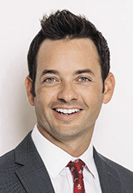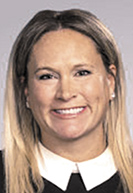Subscriber Benefit
As a subscriber you can listen to articles at work, in the car, or while you work out. Subscribe NowWhen a high-profile college athlete puts fans in the seats and drives up sports revenue at their universities, does it primarily benefit them or their schools?
A Third Circuit Court of Appeals ruling earlier this month in Johnson v. National Collegiate Athletic Association examined that question and could put an end to the idea of amateurism in NCAA sports, with the court holding that a test be developed to determine students that play sports for fun and those whose effort “crosses the legal line into work,” according to the Associated Press.
College athletes whose efforts primarily benefit their schools might qualify as employees deserving of pay under the Fair Labor Standards Act.

James Nussbaum, a partner in Church Church Hittle & Antrim’s Indianapolis office, said the Third Circuit Court opinion points to the difficulties of establishing a test to determine who is an employee and who is not.
He said a lot of the issues surrounding employee status will likely boil down to the question of who’s getting the primary benefit from a student’s participation in intercollegiate sports.
Nussbaum himself played football as a walk-on at Northwestern University.
“I was probably the primary beneficiary of playing there,” Nussbaum said.
In the Third Circuit opinion, U.S. Circuit Judge L. Felipe Resrepo wrote, “With professional athletes as the clearest indicators, playing sports can certainly constitute compensable work. Ultimately, the touchstone remains whether the cumulative circumstances of the relationship between the athlete and college or NCAA reveal an economic reality that is that of an employee-employer.”
A colleague, in a concurring opinion, questioned the difficulty of such a process, noting that nearly 200,000 students compete on nearly 6,700 Division I teams.

The ruling follows a 2021 Supreme Court decision that led the NCAA to amend its rules to allow athletes to profit from their name, image and likeness, or NIL.
Josh Schaub, a sports and business law attorney with Gutwein Law, said he expects more litigation on the issue.
“I think this is going to create more questions than it answers,” Schaub said of the opinion.
Schaub said for him, the true definition of an amateur athlete is a college club athlete that raises their own money for their particular sport and derives no economic benefits for participation.
Athletes on scholarships do receive an economic benefit, he noted.
Schaub said the NCAA will not “give up the ghost” that athletes are not employees, even though the association instituted its NIL policy in 2021 allowing student-athletes to make money from their personal brand.
“The consumer doesn’t care if athletes are paid or not,” Schaub said.

Jen Jackman, a partner with Ice Miller, said a test may look at some sort of minimum eligibility criteria in terms of how much profit a university derives and also check the benefits each athlete gets by playing.
Tuition paid by the university, access to free tutoring and free student-athlete health care benefits through the school could all be considered benefits.
Jackman said playing sports could also be considered a platform for professional recruitment.
“Obviously that’s only going to apply in certain sports,” Jackman said.
Details of Johnson v. NCAA, test
Megan Wright, NCAA associate director of communications, emailed Indiana Lawyer a statement regarding the ruling.
“Our focus remains on the ongoing effort we are leading to modernize college sports. The NCAA is expanding core guaranteed benefits for student-athletes to include health insurance, scholarships, academic counseling, mental health support, and career preparation,” the statement reads. “The Association is also advancing a proposal to allow schools to deliver far greater direct financial benefits to student-athletes. In modernizing college sports, student-athlete leadership from all three divisions agree that college athletes should not be forced into an employment model, which they expect will harm their experiences and needlessly cost countless student-athletes opportunities in women’s sports, Olympic sports, and sports at the HBCU and Division II and Division III levels.”
The NCAA also pointed to a concurring opinion from the Third Circuit, where the judge specifically stated these issues would be better addressed by Congress given all the potential impacts on other areas of the law.
With its statement, the association argued that the decision leaves a ton of uncertainty about the status of student-athletes across all three of its divisions. Around 57% of student-athletes in Division I receive athletic aid, according to the NCAA.
The unanimous Supreme Court decision that spawned the NIL payments lifted the ban on college compensation beyond full-ride scholarships.
But that case did not resolve whether college athletes are employees entitled to direct pay — the key issue before the 3rd U.S. Circuit Court panel.
The Associated Press reported that in 2021, a top lawyer for the National Labor Relations Board said in a memo that college athletes should be treated as school employees.
The NCAA, at its convention, compared the athletes to students who perform in theater groups, orchestras and other campus activities without pay.
How could athletic competition be affected?
Nussbaum said there have already been different tiers created, competition-wise, in intercollegiate sports between universities that generate more revenue than others, like Ohio State University and Texas A&M University in football.
He anticipates that will continue with any test or legal fallout stemming from the Third Circuit Court opinion.
“Schools will have to figure out where to get the money,” Nussbaum said.
Nussbaum said the Third Circuit’s opinion and concurrence were happy to point out problems with a district court’s previous ruling, but offered limited guidance on how a test should be devised to determine employee status.
As to what the future may bring with student-athletes and employee status, Nussbaum said universities could draw up employment contracts that are similar to template agreements used with coaches.
The attorney said most student-athletes deemed employees would probably not have a lot of room to negotiate contracts, but highly recruited athletes coming into college might have a little more leverage.
Jackman said different NCAA programs are going to generate varying amounts of revenue, depending on the sport.
She lauded the NIL policy as “great.”
“I think it solves a lot of the issues,” Jackman said.
If student-athletes can be paid in addition to NIL, it will have an effect on the level of competition, she said.
Also, the possibility of student-athletes unionizing is not appealing to her.
Jackman called it a “slippery slope,” and wonders if athletes could use collective bargaining to determine things like playing time and practice time.
“But I think that is entirely possible if the courts keep going in the direction they’re going,” Jackman said.
Jackman said if only some university’s student-athletes unionize, due to state laws, the NCAA will have to figure out new rules that deal with that possibility across the board with all of its member universities.•
Please enable JavaScript to view this content.

